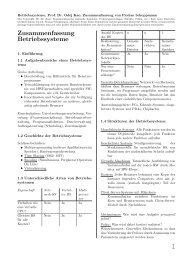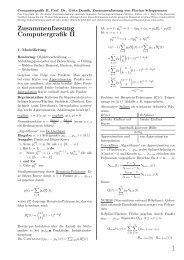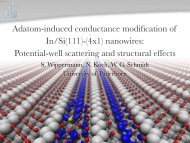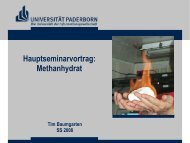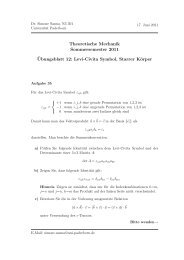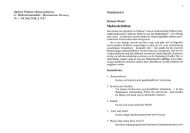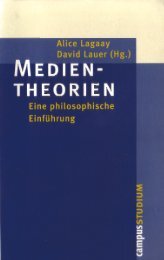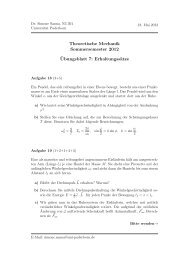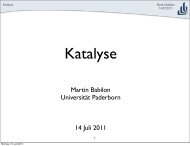Skript / lecture notes - Universität Paderborn
Skript / lecture notes - Universität Paderborn
Skript / lecture notes - Universität Paderborn
Erfolgreiche ePaper selbst erstellen
Machen Sie aus Ihren PDF Publikationen ein blätterbares Flipbook mit unserer einzigartigen Google optimierten e-Paper Software.
Prof. Dr. Wolf Gero Schmidt<br />
<strong>Universität</strong> <strong>Paderborn</strong>, Lehrstuhl für Theoretische Physik<br />
Loch hat negative Energie The hole has a negative energy<br />
ɛ hole<br />
K = −ɛ K (8.1)<br />
(Loch will aufsteigen, Teilchen absteigen The hole gains energy by moving up, the particle<br />
releases energy by moving down)<br />
⇒ zeitabhängige Wellenfunktion des Lochs time-dependent antiparticle wave function<br />
ψ hole<br />
+ = Φ K e −i(−ɛ K)t/<br />
= Φ K e iɛ Kt/<br />
ɛ K < ɛ F (8.2)<br />
(8.3)<br />
D.h. Loch im Teilchen–Loch–Bild kann interpretiert werden als ein Teilchen, das in der<br />
Zeit rückwärts läuft. The hole may be understood as a particle that moves back in time<br />
in the particle-hole representation.<br />
Gesamtwellenfunktion nicht wechselwirkender Teilchen ist das Produkt der Einteilchenwellenfunktionen,<br />
bei identischen Fermionen muß sie jedoch antisymmetrisch werden.<br />
The many-body wave function of non-interacting particles may be written as product of<br />
the single-particle orbitals. In case of Fermions, however, it needs to be antisymmetric.<br />
→ Slater–Determinante Slater determinant<br />
∣ ∣∣∣∣∣∣<br />
Φ K1 ,...,K n<br />
(r 1 , . . . , r N ) = √ 1<br />
Φ K1 (r 1 ) . . . Φ K1 (r N )<br />
.<br />
.<br />
N! Φ KN (r 1 ) . . . Φ KN (r N ) ∣<br />
(8.4)<br />
Bem: Im Falle von WW der Teilchen untereinander können die korrekten Vielteilchenwellenfunktionen<br />
als Linearkombination von Slaterdeterminanten dargestellt werden.<br />
In the case that the particles interact the correct many-body wave function<br />
may be written as linear combination of Slater determinants.<br />
Vereinfachen die Notation, indem wir nur die Besetzung der Einteilchenorbitale berücksichtigen<br />
Simplify the notation by restricting ourselves to the occupation of the singleparticle<br />
orbitals<br />
Φ K1 ,...,K N<br />
(r 1 , . . . , r N ) → |n 1 , n 2 , n 3 , . . .〉 (8.5)<br />
mit n i = 0 oder 1 (Pauli–Prinzip) where n i = 0 or 1 (Pauli principle). This is called<br />
”occupation number notation” and reminds us of the shell notation for atoms, e.g.,<br />
(1s) 2 (2s) 2 (2p) 1 .<br />
Damit angeregter Zustand von vorhin The excited state discussed previously is thus given<br />
as<br />
|1 1 , 1 2 , 0 3 , 1 4 , 1 5 , 0 6 , 0 7 , 1 8 , . . .〉 (8.6)<br />
Gehen jetzt wieder ins Teilchen–Loch–Bild und halten nur Änderungen vom Grundzustand<br />
fest. Now in most cases of interest the systems are weakly excited, i.e., only a few<br />
156




